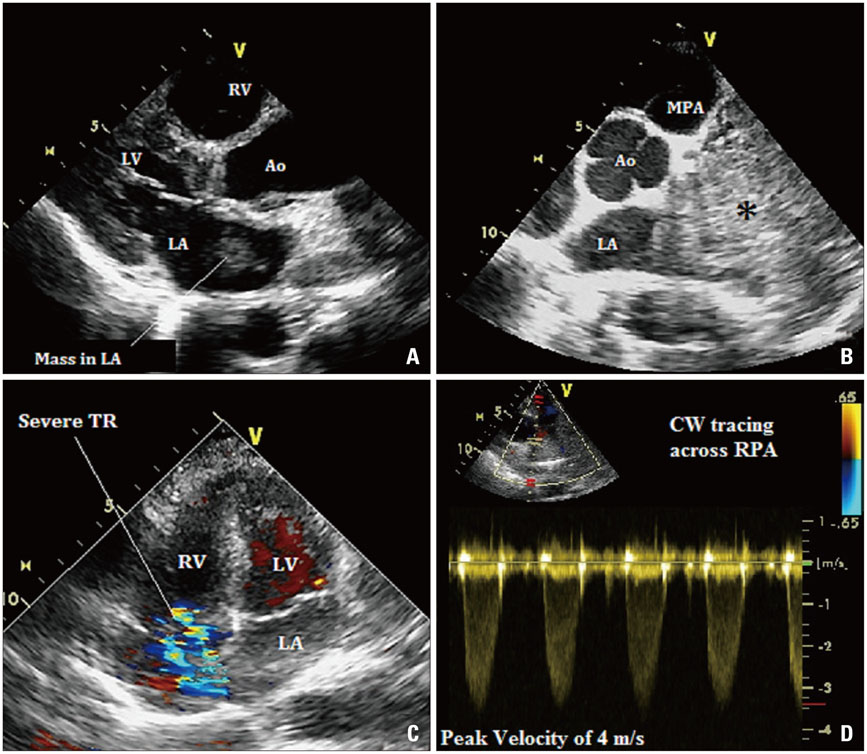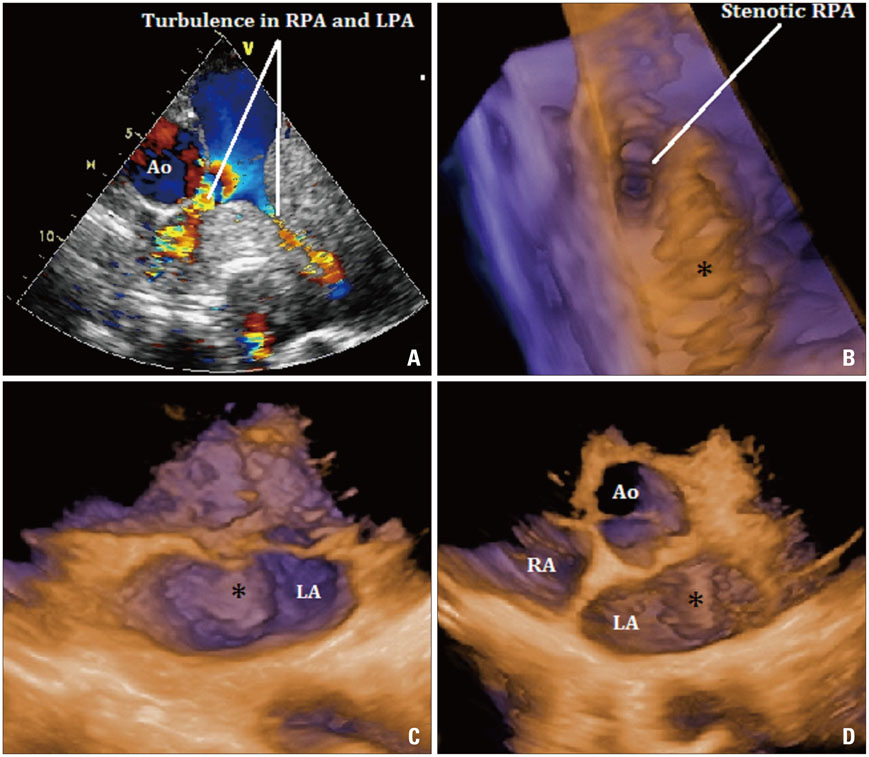J Cardiovasc Ultrasound.
2014 Dec;22(4):209-212. 10.4250/jcu.2014.22.4.209.
Pulmonary Artery Stenosis due to Lung Carcinoma: A Rare Cause of Dyspnea
- Affiliations
-
- 1Department of Cardiology, King George's Medical University, Lucknow, Uttar Pradesh, India. raj_iv_infusion@yahoo.co.in
- KMID: 1980425
- DOI: http://doi.org/10.4250/jcu.2014.22.4.209
Abstract
- Acquired bilateral pulmonary artery stenosis in adults due to lung malignancy is infrequently reported. We describe an adult male who presented to us with chief complaints of dyspnea on exertion and one episode of hemoptysis. Two dimensional transthoracic echocardiography with color Doppler showed presence of an extra cardiac mass causing severe extrinsic compression of both the right and left pulmonary artery leading to high pressure severe tricuspid regurgitation and extension of the mass into the left atrium. Three dimensional transthoracic echocardiography clearly delineated the anatomy of the left atrial mass and its surrounding anatomical relationship. The diagnosis of non small cell lung carcinoma was confirmed by multidetector computed tomography (MDCT) and with MDCT guided biopsy with histopathology. Patient succumbed one month later due to an episode of massive hemoptysis.
MeSH Terms
Figure
Reference
-
1. Viseur P, Unger P. Doppler echocardiographic diagnosis and follow-up of acquired pulmonary stenosis due to external cardiac compression. Cardiology. 1995; 86:80–82.
Article2. American College of Cardiology. American Heart Association Task Force on Practice Guidelines (Writing Committee to revise the 1998 guidelines for the management of patients with valvular heart disease). Society of Cardiovascular Anesthesiologists. Bonow RO, Carabello BA, Chatterjee K, de Leon AC Jr, Faxon DP, Freed MD, Gaasch WH, Lytle BW, Nishimura RA, O'Gara PT, O'Rourke RA, Otto CM, Shah PM, Shanewise JS, Smith SC Jr, Jacobs AK, Adams CD, Anderson JL, Antman EM, Fuster V, Halperin JL, Hiratzka LF, Hunt SA, Lytle BW, Nishimura R, Page RL, Riegel B. 2006 guidelines for the management of patients with valvular heart disease: a report of the American College of Cardiology/American Heart Association Task Force on Practice Guidelines (writing Committee to Revise the 1998 guidelines for the management of patients with valvular heart disease) developed in collaboration with the Society of Cardiovascular Anesthesiologists endorsed by the Society for Cardiovascular Angiography and Interventions and the Society of Thoracic Surgeons. J Am Coll Cardiol. 2006; 48:e1–e148.3. Plana JC. Three-dimensional echocardiography to assess intra-cardiac masses. In : Badano LP, Lang RM, Zamorano JL, editors. Textbook of real-time three dimensional echocardiography. London: Springer-Verlag;2011. p. 111–119.
- Full Text Links
- Actions
-
Cited
- CITED
-
- Close
- Share
- Similar articles
-
- Air Way Instability due to Pulmonary Artery Sling combined with Diffuse Tracheal Stenosis
- Acquired pulmonary stenosis secondary to tuberculosis: A Case Report
- Stenosis of Individual Pulmonary Veins
- Pulmonary Artery Sling with Situs Solitus Dextroposition of Heart and Left Superior Vena Cava
- Unilateral Absence of Pulmonary Artery





